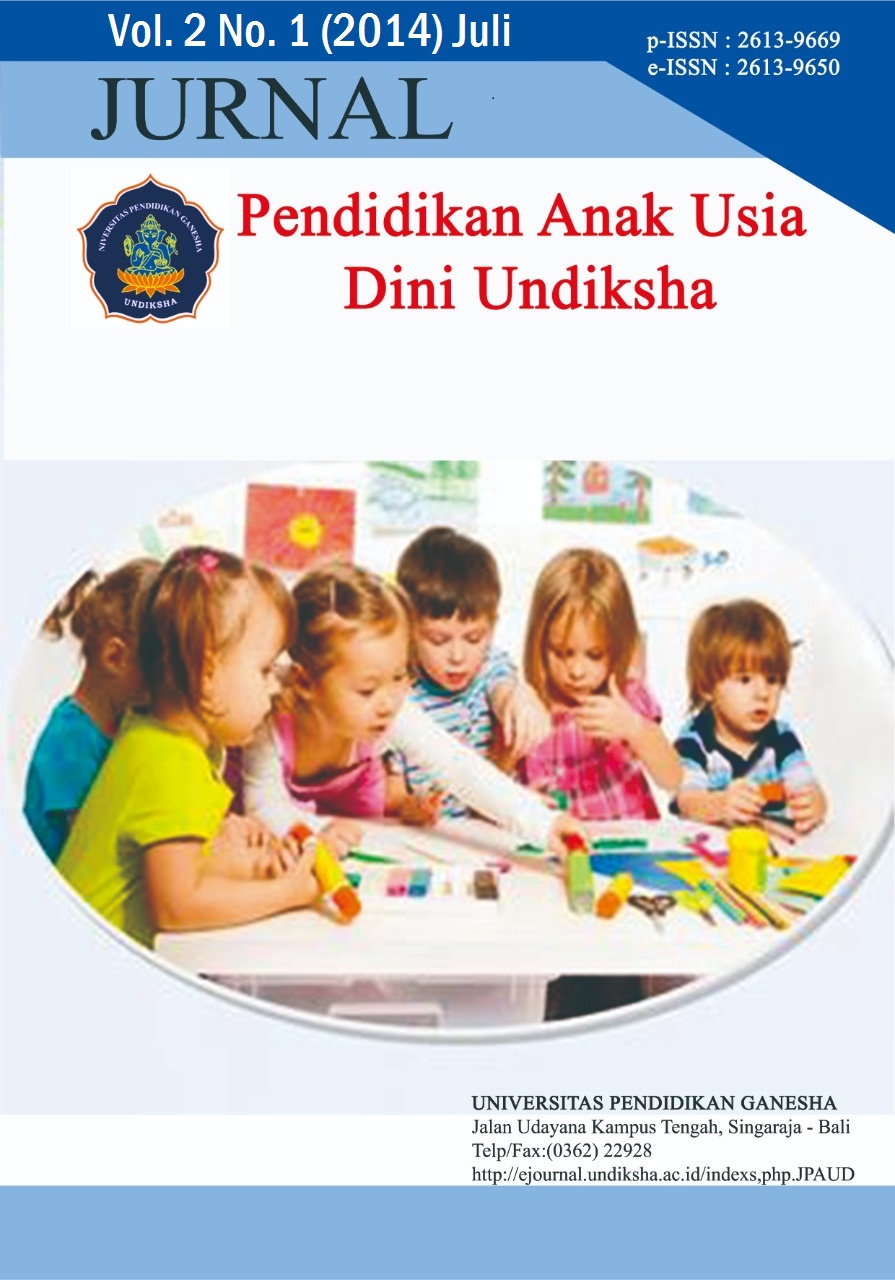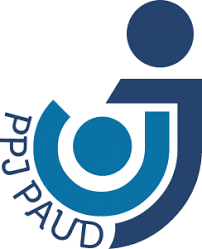PENERAPAN METODE PEMBERIAN TUGAS BERBANTUAN MEDIA KARTU ANGKA UNTUK MENINGKATKAN KEMAMPUAN KOGNITIF MENGENAI LAMBANG BILANGAN PADA ANAK KELOMPOK A SEMESTER II DI TK LAKSANA KUMARA DENPASAR TAHUN AJARAN 2013/2014
DOI:
https://doi.org/10.23887/paud.v2i1.3241Abstract
Penelitian ini bertujuan untuk mengetahui peningkatan kemampuan kognitif mengenai lambang bilangan melalui penerapan metode pemberian tugas berbantuan media kartu angka pada anak kelompok A semester II tahun ajaran 2013/ 2014. Jenis penelitian ini adalah penelitian tindakan kelas yang dilaksanakan dalam dua siklus. Dalam setiap siklus terdiri dari tahapan perencanaan tindakan, pelaksanaan tindakan, observasi atau evaluasi dan refleksi. Subyek penelitian ini adalah 27 anak kelompok A semester II TK Laksana Kumara Denpasar pada tahun ajaran 2013/2014. rerata hasil belejar anak pada observasi awal sebesar 37%. Data hasil belajar dalam penelitian ini dikumpulkan dengan metode observasi. Data yang telah dikumpulkan dianalisis menggunakan metode analitis deskriptif dan deskriptif kuantitatif. Dari hasil analisis data yang diperoleh dapat diketahui hasil belajar siswa di siklus I sebesar 52,07% dan di siklus II sebesar 86,29%. dalam hal ini terjadi peningkatan sebesar 15,07% dari observasi awal ke siklus I, kemudian meningkat 34,22% dari siklus I ke siklus II. Hasil penelitian menunjukkan bahwa penerapan metode pemberian tugas berbantuan media kartu angka dapat meningkatkan kemampuan kognitif mengenai lambang bilangan pada anak kelompok A semester II TK Laksana Kumara tahun ajaran 2013/2014.Kata Kunci : metode, pemberian tugas, media kartu angka, siklus dan kemampuan kognitif
This research aims at finding cognitive competence about number symbols through applying a task giving method with number card media to the children group A semester II academic year 2013/2014. Type of this research is a class action research conducted in two cycles. Each cycle consists of action plan, action implementation, observation, and reflexion. Subject of this research is totally 27 children of group A semesetr II Kindergarten Laksana Kumara Denpasar in academic year 2013/2014. The average of student learning result on first observation is 37%. Data of learning result in this research was collected by observation method. The collected data was analyzed by method of descriptive statistic analytic and quantitative descriptive. From data analysis if could be concluded the student learning result on cycle I is 52,07% nd in cycle II is 86,29%. In this case, there was an increase of 15,07% from first observation to cycle I, then if increased about 34,22% from cycle I to cycle II. The result shows that the application of task giving method with number card media can improve cognitive competence about number symbols of the children of group A semester II Kindergarten Laksana Kumara academic year 2013/2014.
keyword : method, task giving, number card media, cycle, adn cognitive competence
Published
2014-07-05
How to Cite
., N. K. S. S., ., D. S. P. M., & ., D. I. W. D. (2014). PENERAPAN METODE PEMBERIAN TUGAS BERBANTUAN MEDIA KARTU ANGKA UNTUK MENINGKATKAN KEMAMPUAN KOGNITIF MENGENAI LAMBANG BILANGAN PADA ANAK KELOMPOK A SEMESTER II DI TK LAKSANA KUMARA DENPASAR TAHUN AJARAN 2013/2014. Jurnal Pendidikan Anak Usia Dini Undiksha, 2(1). https://doi.org/10.23887/paud.v2i1.3241
Issue
Section
Articles
License
Authors who publish with the Jurnal Pendidikan Anak Usia Dini Undiksha agree to the following terms:
- Authors retain copyright and grant the journal the right of first publication with the work simultaneously licensed under a Creative Commons Attribution License (CC BY-SA 4.0) that allows others to share the work with an acknowledgment of the work's authorship and initial publication in this journal.
- Authors are able to enter into separate, additional contractual arrangements for the non-exclusive distribution of the journal's published version of the work (e.g., post it to an institutional repository or publish it in a book), with an acknowledgment of its initial publication in this journal.
- Authors are permitted and encouraged to post their work online (e.g., in institutional repositories or on their website) prior to and during the submission process, as it can lead to productive exchanges, as well as earlier and greater citation of published work. (See The Effect of Open Access)











